
table of contents
- Blue bugs
- Bluish purple beetles
- Blue-green bugs
- frequently asked Questions
Many different beetle species are native to Germany, including many blue-colored ones. Some of these insects are described here with their characteristics.
In a nutshell
- bluish beetles are common everywhere
- some species are difficult to distinguish from one another
- many blue species have a metallic shimmer
- they eat wood, insects or pollen
Btepid bugs
alpine buck (Rosalia alpina)
The alpine longicorn is a very beautiful blue beetle, which is unfortunately native, but is becoming increasingly rare. Although the name suggests otherwise, its occurrence is not limited to the Alps.

- Appearance: light gray-blue with dark spots, conspicuous long antennae, blue with black rings
- Size: up to 4 cm in length
- Occurrence: at higher altitudes
- Food: the larvae feed on freshly cut beech wood, what the beetle eats is not entirely clear
- Reproduction: Mating takes place near suitable breeding trees, males are slightly smaller, females lay eggs individually in the wood
Blue Bearded Runner (Leistus spinibarbis)
This beetle is also called thorn beard. He has a very hidden way of life.

- Appearance: colored blue to violet, but also brownish, cover wings with longitudinal grooves
- Size: up to 9 mm
- Occurrence: in warmer areas, forest areas, on heathland
- Food: lives predatory, catches springtails
Blue pine jewel beetle (Phaenops cyanea)
The blue pine jewel beetle is an important pest, particularly in pine stands. It can cause lasting damage to trees and cause them to die.
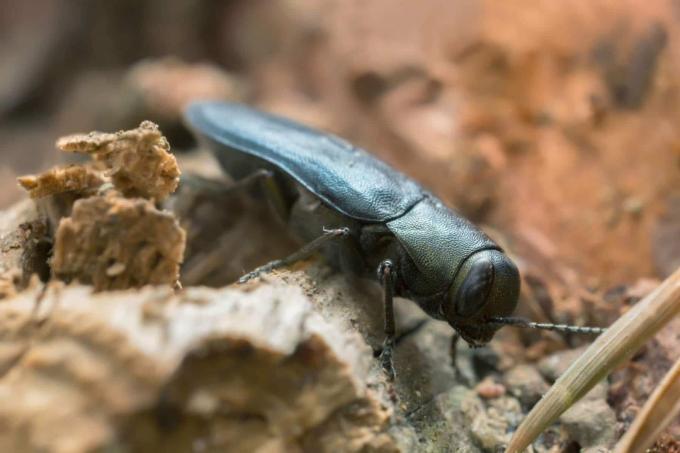
- Appearance: also green or black
- Size: beetle up to 12 mm, larva up to 20 mm
- Occurrence: in spruce or pine forests
- Food: Spruce or pine wood
- Reproduction: Larvae live in the bark of infested trees, development takes 2 years
Blue alder leaf beetle (Agelastica alni)
Both the beetles and their larvae like to eat alder leaves. If they occur in large numbers, they can partially bare trees, but do not cause any lasting damage.

- Appearance: bluish, greenish or black, somewhat rounded shape
- Size: up to 7 mm
- Occurrence: on alders in damp areas
- Food: alder leaves
- Reproduction: Females lay the eggs on the underside of the leaves, after 2 weeks the dark larvae hatch
Blue Longhorn Beetle (Ischnomera cyanea)
The adult insects fly mainly in late spring. They prefer different flowering plants.
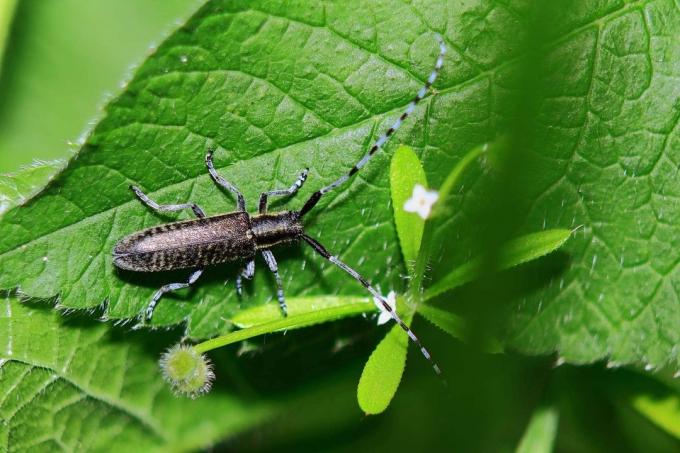
- Appearance: elongated shape, blue to greenish, several longitudinal grooves on the elytra
- Size: up to 10 mm
- Occurrence: in deciduous forests
- Food: Beetles eat flower pollen and nectar
- Reproduction: the larvae live in rotten wood
Blue milkweed beetle (Chrysochus asclepiadeus)
This blue beetle never strays too far from its host plants. Although both the adult animals and the larvae eat it, they do little damage.
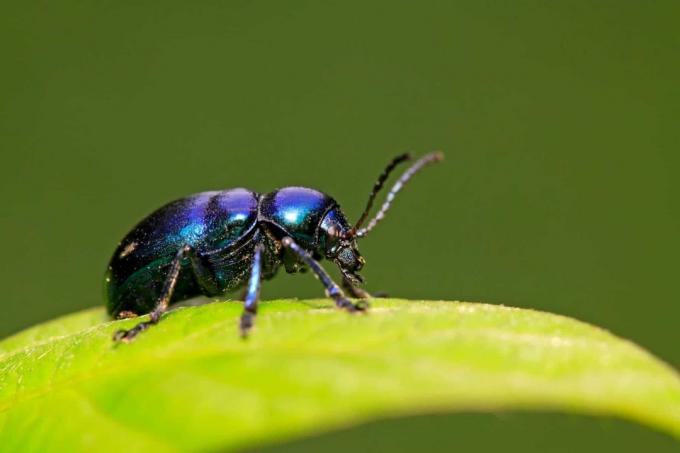
- Appearance: dark blue to violet, shimmering metallic
- Size: up to 10 mm
- Occurrence: in forests or meadows
- Food: milkweed
- Reproduction: the larvae feed on the roots of the host plant, development takes 3 years
bluish violet Beetle
Bluish purple paw beetle (Timarcha goettingensis)
The bluish-purple paw beetle is so named because of its thick feet. Despite his portly appearance, he is very agile.

- Appearance: thick body, blue-black to dark purple, unable to fly, thickened distal phalanges
- Size: up to 11 mm
- Occurrence: on lean or dry grassland
- Food: bedstraw
- Reproduction: Development takes up to 3 years
Blue-violet disc buck (Callidium violaceum)
This disc buck is very site-loyal. It can develop over decades in the same wood.
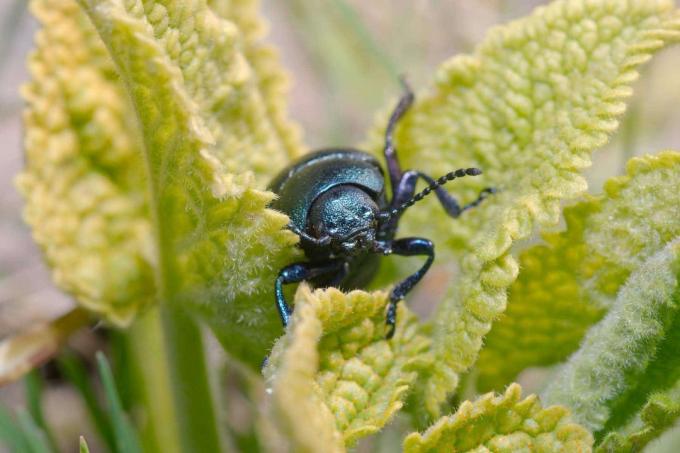
- Appearance: metallic blue, violet or green, body spotted
- Size: up to 16 mm
- Occurrence: coniferous forests
- Food: Larvae eat wood
- Reproduction: Larvae infest mainly coniferous wood, development takes 2 years
Blue-violet ground beetle (Carabus problematicus)
The ranger is a species of beetle that is very noticeable once found in the forest. He withdraws under stones or in dead wood.
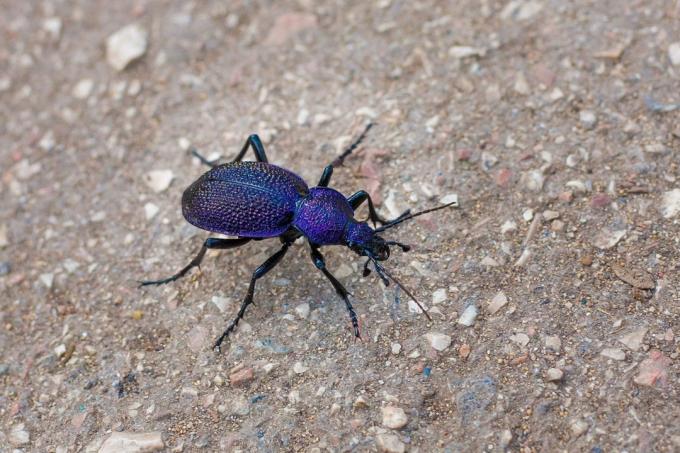
- Appearance: blue-violet, elytra with longitudinal grooves
- Size: up to 30 mm
- Occurrence: Native to the low mountain ranges, mainly in the forest
- Food: lives predatory and preys on others insects and their larvae
Notice: This beetle is not only big, it is also defensive, it can bite painfully.
Blue-green bugs
Broad willow leaf beetle (Plagiodera versicolora)
This little blue beetle is hard to find as it lives high up in trees. It forms several generations per year.

- Appearance: teal, blue, green or coppery, spherical shape
- Size: up to 4.5 mm
- Occur in pastures or poplars
- Food: Larvae eat the leaves of the host plant
Dark blue ground beetle (Carabus intricatus)
This ground beetle cannot fly. Because of this, it finds it difficult to move around, so it is often found in the same area.
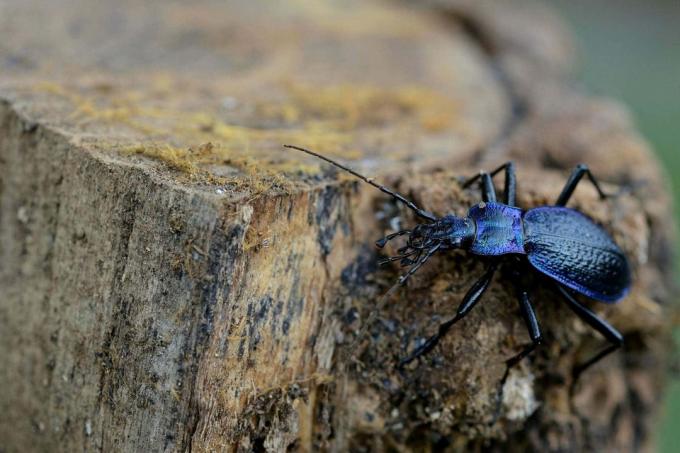
- Appearance: different shades of blue depending on the incidence of light, elytra with longitudinal grooves
- Size: up to 36 mm
- Occurrence: in southern Germany, likes warmer areas
- Food: mainly lives as a predator, but also eats fallen fruit
Green-blue show beetles (Lebia chlorocephala)
The green-blue show beetle is variably colored. Sometimes the blue tone predominates, sometimes the green tone.

- Appearance: elytra blue-green, legs and pronotum yellowish or reddish brown
- Size: up to 8 mm
- Occurrence: Population is declining, prefers moist areas
- Food: Larvae parasitize the pupae of other beetle species
- Reproduction: Eggs are laid in multiples in spring, larvae actively search for hosts
Sky blue leaf beetle (Chrysomela coerulans)
Due to its colour, this very small leaf beetle immediately catches the eye.
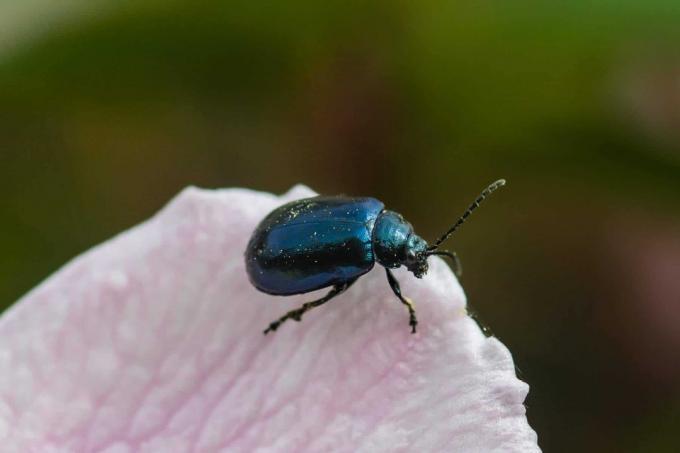
- Appearance: various shades of blue, but also black, copper or green
- Size: up to 9 mm
- Occurrence: in summer on damp meadows
- Food: various types of mint
Notice: This blue beetle species can also cause damage to mint plants in the garden, but these are not so serious that control would be necessary.
Small Bombardier Beetle (Brachinus explodes)
A feature of bombardier beetles is their defense mechanism. They have a blast chamber in their abdomen that they can use to shoot foul-smelling gases.
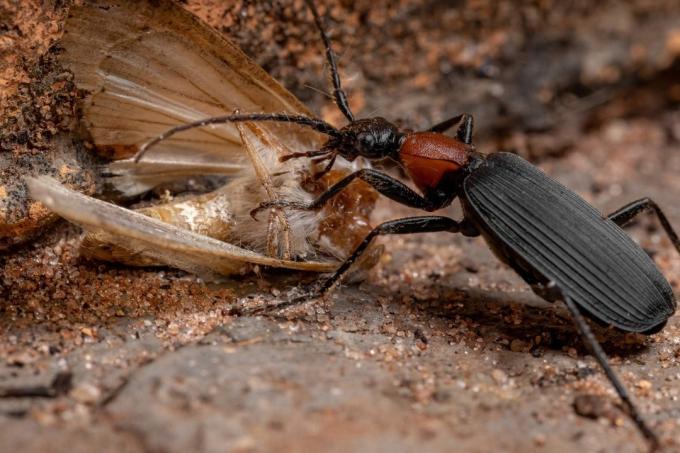
- Appearance: Body is red, elytra blue-green
- Size: up to 7.5 mm
- Occurrence: at lower altitudes, likes warmth, in forests, on meadows, under stones, lives sociable
- Food: Larvae eat pupae of other insects
- Reproduction: Larvae actively search for hosts, development takes around 20 days
Metal-colored linden beetle (Stenostola Dubia)
Although the larvae of this blue beetle eat wood, they prefer pieces of wood that are already on the ground. Therefore, the insect is not considered a pest.

- Appearance: slender build, body black, elytra metallic black-blue
- Size: up to 13 mm
- Occurrence: near various deciduous trees
- Food: Larvae eat wood, mainly linden tree
- Reproduction: in dying wood, laying eggs in early summer
Red-necked Grain Chicken (Oulema melanopus)
This beetle belongs to the grain pests. He has few natural enemies.
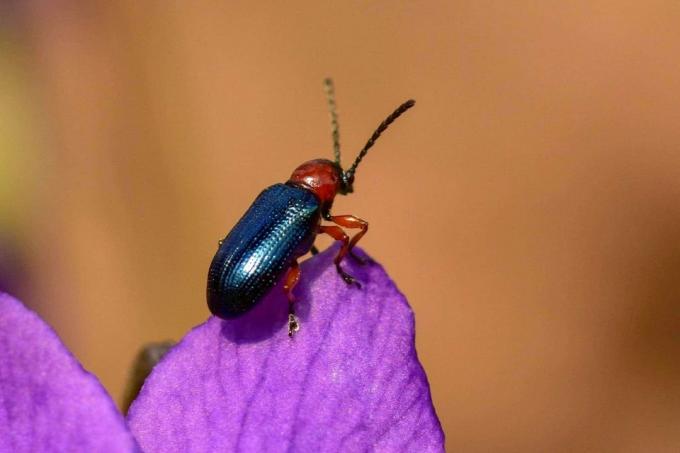
- Appearance: body red, elytra black, metallic blue, green-blue or green, spotted
- Size: up to 4.5 mm
- Occurrence: Forest edges, meadows and fields
- Food: Grains of all kinds
- Reproduction: females lay eggs on cereal plants or grasses, pupation takes place in the soil
Six-spot cleaning beetle (Agonum sexpunctatum), Six-Point Shiny Flatrunner
The body of this blue beetle has a metallic sheen. However, he prefers a hidden way of life.
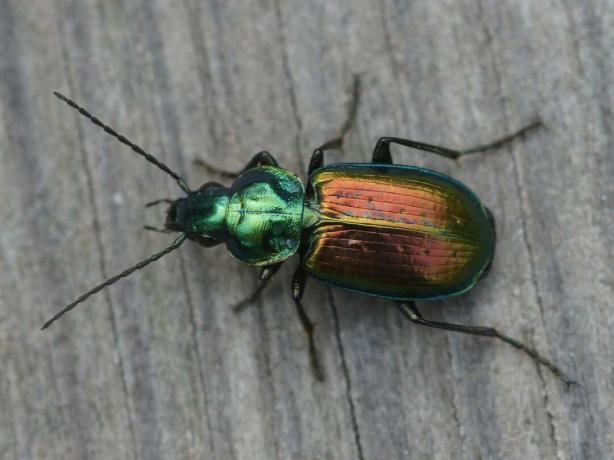
- Appearance: Head and neck metallic green, elytra blue, green, reddish gold, black
- Size: up to 9.5 mm
- Occurrence: Forests, meadows, moors, fields
- Food: Predatory, mainly small insects
Black-blue oil beetle (Meloe proscarabaeus)
This species is also known as the black mayworm. It bears little resemblance to other typical beetle species.

- Appearance: stocky body, shortened elytra, black-blue
- Size: up to 35 mm
- Occurrence: dry meadows and green spaces, more on sandy than on loamy soil, now rare
- Food: Larvae parasitize on solitary bees, adult oil beetles feed on plants
- Reproduction: Larvae climb flowers and are taken by bees, in the bee's burrow they switch to their larvae
Fake cabbage flea (Altica oleracea)
The loggerhead flea is so small that it is difficult to identify. It is quite common on field edges or meadows.

- Appearance: blue-green, blue, green or golden-green, elytra dotted
- Size: up to 4 mm
- Occurrence: in bushes, hedges and shrubs
- Food: mainly fireweed species
- Reproduction: in summer, larvae feed on the host plants
Variable Schönbock (Phymatodes testaceus)
The Schönbock rightly bears its name because it can be very differently colored. It is considered a pest, especially on oak wood, but does not attack barkless wood.

- Appearance: legs and neck brown, head dark, wings very variable from yellow to green to bluish
- Size: up to 16 mm
- Occurrence: in deciduous forests and gardens with fruit trees
- Food: Wood, especially Oak
- Reproduction: Larvae eat wood, development takes up to 2 years
forest dung beetle (Anoplotrupes stercorosus)
The blue dung beetle is particularly noticeable when many specimens gather in a larger pile of dung. They are very common in most forests, including on forest roads.

- Appearance: black-blue, elytra can also be greenish or violet
- Size: up to 19 mm
- Occurrence: in deciduous - especially in beech forests
- Diet: animal droppings of various species
- Reproduction: the adult insects dig burrows in the ground, take animal droppings there and lay their eggs
frequently asked Questions
Some beetle species and especially their larvae can actually cause damage to crops or in the forest. However, this does not apply to everyone. The adult insects in particular are sometimes content with nectar and pollen from flowering plants, others are predatory and are more likely to be beneficial insects.
There are different species of beetles almost everywhere. In the forest, on meadows, in the water and in the home garden. If you want to find beetles, you have to search more carefully. Most species are very good at hiding.
There are many species of beetles that are protected by law, and some that are so rare that they are rarely seen. Beetles, which are commonly considered pests, are often not particularly protected.

